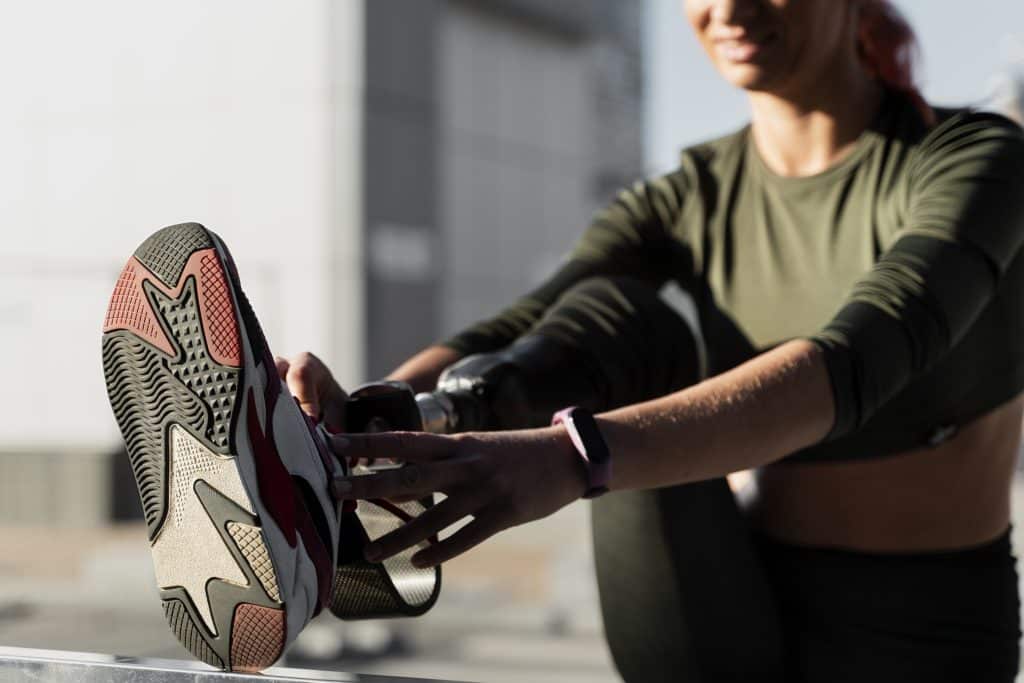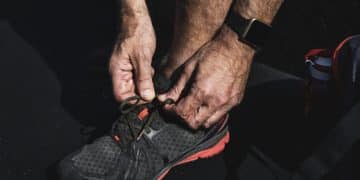Footwear Comfort Testing: 8-Hour Wearability Standards Explained

Footwear brands implement sophisticated comfort testing methodologies, integrating biomechanical assessments and material analysis, to meticulously ensure their products consistently achieve and surpass demanding 8-hour wearability standards, thereby optimising consumer satisfaction.
Have you ever wondered what goes into making a shoe truly comfortable, especially for extended periods? The quest for ultimate wearability is a driving force behind innovation in the footwear industry. This article delves into the intricate world of footwear comfort testing, exploring how leading brands meticulously measure and ensure their products meet rigorous 8-hour wearability standards.
The science of comfort: beyond initial feel
True footwear comfort extends far beyond the initial sensation when slipping on a new pair of shoes. It encompasses a complex interplay of factors that contribute to sustained well-being and performance over hours of wear. Brands invest heavily in understanding these nuances, moving from subjective feedback to objective, data-driven analysis to define and quantify comfort.
The human foot is an intricate biomechanical marvel, and its interaction with footwear is equally complex. Factors such as pressure distribution, shock absorption, temperature regulation, and flexibility all play critical roles in determining whether a shoe remains comfortable after an 8-hour shift, a long walk, or a demanding athletic event. Brands recognise that a shoe might feel great for five minutes but become a source of discomfort or even pain after prolonged use, hence the focus on long-duration wearability.
defining 8-hour wearability standards
Establishing an ‘8-hour wearability standard’ is not a simple task; it involves setting benchmarks across various comfort parameters. These standards are often internal to brands but are increasingly influenced by consumer expectations and competitive landscapes. They typically cover:
- Pressure mapping thresholds: Ensuring no excessive pressure points develop over time.
- Cushioning degradation: Maintaining effective shock absorption throughout the wear period.
- Temperature and moisture management: Preventing hotspots and keeping the foot dry.
- Stability and support: Sustaining proper foot alignment and reducing fatigue.
Ultimately, the goal is to create a product that supports the foot’s natural mechanics, minimises fatigue, and prevents discomfort, even under continuous stress. This holistic approach ensures that comfort is not just a feature but a fundamental aspect of the shoe’s design and engineering.
Biomechanical analysis: understanding foot-shoe interaction
Biomechanical analysis forms the bedrock of modern footwear comfort testing. This scientific discipline studies the mechanics of living organisms, and in the context of footwear, it meticulously examines how the foot interacts with the shoe during various activities. Advanced laboratories are equipped with an array of sophisticated tools to capture incredibly precise data.
One of the primary tools used is pressure mapping technology. This involves placing thin, sensitive mats or insoles equipped with hundreds of pressure sensors inside shoes. As a wearer walks, runs, or stands, these sensors record the force exerted at different points across the sole of the foot. This data is then visualised as a dynamic pressure map, often using a colour gradient where red indicates high pressure and blue indicates low pressure.
gait analysis and motion capture
Beyond static pressure points, understanding dynamic movement is crucial. Gait analysis systems employ high-speed cameras and reflective markers placed on the wearer’s body and shoes. These systems track joint angles, stride length, cadence, and foot strike patterns. By analysing these parameters, researchers can identify inefficiencies in movement, potential areas of stress, and how the shoe influences natural gait mechanics.
- Force plates: Integrated into walkways, these measure ground reaction forces as the foot makes contact, providing insights into impact absorption and energy return.
- Electromyography (EMG): Sensors placed on leg muscles measure electrical activity, revealing muscle exertion and fatigue patterns during wear.
- 3D foot scanning: Captures detailed anatomical data of the foot, allowing for precise last design and fit optimisation.
These biomechanical insights allow designers to make informed decisions about shoe geometry, cushioning placement, and support structures. For instance, if pressure mapping reveals consistent hotspots under the metatarsal heads after several hours, adjustments can be made to the insole or midsole to redistribute pressure more evenly. This iterative process of testing, analysing, and refining is essential for achieving optimal 8-hour wearability.
Material science: the foundation of lasting comfort
The materials used in footwear are paramount to its comfort and durability, especially when aiming for 8-hour wearability standards. From the plushness of the upper to the resilience of the midsole and the grip of the outsole, every component plays a critical role. Material scientists work tirelessly to innovate and select materials that offer the perfect balance of cushioning, support, breathability, and durability.
Midsoles, often made from EVA (ethylene-vinyl acetate) foams or advanced polyurethane blends, are crucial for shock absorption and energy return. However, these materials can degrade over time, losing their cushioning properties. Brands conduct extensive fatigue testing, subjecting midsole samples to thousands or even millions of compression cycles to simulate years of wear in a compressed timeframe. This ensures the material maintains its performance characteristics throughout the proclaimed lifespan and 8-hour wear period.
innovations in material performance
The pursuit of superior comfort has led to significant advancements in material technology. Brands are constantly exploring new polymers, composites, and weaving techniques. For example, some brands now incorporate responsive foams that adapt to the wearer’s foot shape over time, or use advanced knitting techniques for uppers that offer a sock-like fit with targeted support and breathability.
- Breathable membranes: Materials like Gore-Tex or proprietary brand technologies are used to allow moisture vapour to escape while preventing water ingress, keeping feet dry and comfortable.
- Antimicrobial treatments: Integrated into linings and insoles to prevent odour-causing bacteria, enhancing hygiene and perceived freshness over long wear periods.
- Sustainable materials: The push for eco-friendly solutions often involves innovative materials that also offer excellent comfort properties, such as recycled plastics in uppers or bio-based foams in midsoles.
The careful selection and rigorous testing of materials ensure that the shoe not only feels comfortable initially but also maintains its structural integrity and comfort properties hour after hour, day after day. This scientific approach to material selection is a cornerstone of meeting stringent wearability standards.
User trials and subjective feedback: the human element
While biomechanical data and material science provide invaluable objective insights, the ultimate test of comfort lies with the human wearer. User trials are an indispensable part of footwear comfort testing, bringing in the subjective experience that objective metrics alone cannot fully capture. These trials involve real people wearing prototypes or finished products in real-world conditions for extended periods, often specifically targeting the 8-hour wear benchmark.
Participants in these trials are carefully selected to represent the target demographic for the footwear – whether they are athletes, healthcare professionals, or everyday consumers. They wear the shoes during their daily routines, recording their experiences through detailed daily logs, questionnaires, and interviews. This qualitative data provides rich context to the quantitative data gathered in the lab.
structured feedback mechanisms
To ensure consistency and comparability, brands employ structured feedback mechanisms. Participants might be asked to rate comfort on a scale for different areas of the foot, describe any areas of discomfort, or comment on overall fit and feel. Questions often focus on specific parameters:
- Initial comfort versus sustained comfort: How does the feel change after 1, 4, or 8 hours?
- Specific pain points: Are there any areas of rubbing, pinching, or excessive pressure?
- Temperature and moisture: Do feet feel too hot, cold, or sweaty?
- Perceived support and stability: Does the shoe feel secure and supportive throughout the day?
This subjective feedback is then correlated with the objective data. For example, if multiple users report discomfort around the arch after 6 hours, and pressure mapping data shows increased pressure in that area over time, it provides compelling evidence for design modification. This human-centred approach ensures that the science of comfort is always grounded in the lived experience of the wearer, making valid the final product’s claim for 8-hour wearability.
Advanced simulation and computational modelling
In addition to physical testing, the footwear industry increasingly leverages advanced simulation and computational modelling to predict and analyse comfort characteristics. These digital tools allow designers and engineers to evaluate countless design iterations and material combinations virtually, significantly speeding up the development process and reducing the need for costly physical prototypes.
Finite Element Analysis (FEA) is a prime example. This technique involves creating a detailed 3D digital model of the foot and the shoe, then dividing it into many small elements. By applying simulated forces and movements, FEA can predict stress, strain, and pressure distribution within the shoe and on the foot. This can reveal potential hotspots or areas of weakness before a single physical prototype is made.
virtual prototyping and predictive analytics
Computational Fluid Dynamics (CFD) can be used to model airflow and heat transfer within the shoe, helping to optimise ventilation and temperature regulation. This is particularly important for athletic footwear or shoes designed for warm climates, where keeping the foot cool and dry is paramount to long-term comfort. By simulating different material porosities and ventilation channel designs, brands can predict their impact on internal shoe climate.
- Digital last design: Customisable 3D foot models allow for precise last modifications to accommodate different foot shapes and ensure optimal fit.
- Wear prediction: Algorithms can predict how materials will degrade or compact over time, informing decisions about durability and sustained cushioning.
- Impact absorption optimisation: Simulations can test various midsole geometries and material compositions to maximise shock absorption without compromising stability.
These digital tools complement physical testing by providing a deeper understanding of complex interactions and allowing for rapid iteration. They enable brands to refine designs based on predictive insights, ensuring that footwear is engineered for sustained comfort and meets the demanding 8-hour wearability standards even before extensive physical trials commence.
The future of comfort testing: personalisation and AI
The landscape of footwear comfort testing is continuously evolving, with exciting advancements on the horizon driven by personalisation and artificial intelligence. The future promises even more precise, individualised comfort solutions, moving away from a one-size-fits-all approach to highly tailored experiences.
One significant trend is the rise of bespoke footwear, enabled by advanced 3D scanning and printing technologies. Consumers can have their feet scanned, and shoes can be custom-made to their exact anatomical specifications, addressing unique foot shapes and biomechanical needs. This level of personalisation inherently optimises comfort for extended wear.
artificial intelligence and machine learning
AI and machine learning are poised to revolutionise data analysis in comfort testing. By processing vast datasets from biomechanical sensors, user trials, and material tests, AI algorithms can identify subtle patterns and correlations that human analysts might miss. This can lead to more accurate predictions of comfort and performance, as well as faster identification of design flaws.
- Predictive comfort models: AI can develop models that predict user comfort based on a combination of objective data (pressure, temperature, gait) and subjective feedback, refining design parameters.
- Generative design: AI can be used to generate novel shoe geometries and material compositions optimised for specific comfort criteria, pushing the boundaries of traditional design.
- Real-time feedback systems: Future footwear might integrate smart sensors that provide real-time comfort feedback to the wearer, or even adjust cushioning dynamically based on activity and fatigue levels.
These emerging technologies promise to elevate footwear comfort to unprecedented levels, making 8-hour wearability not just a standard but a guaranteed experience for every individual. The integration of AI and personalisation will allow brands to create shoes that truly understand and respond to the unique needs of each foot, ensuring enduring comfort.
Challenges and standards in comfort assessment
Despite significant advancements, footwear comfort testing is not without its challenges. The subjective nature of comfort itself poses a fundamental hurdle; what feels comfortable to one person might not to another. Brands must navigate this variability while striving for universal standards that cater to a broad audience.
Standardisation across the industry remains a complex issue. While individual brands have their internal protocols for 8-hour wearability, there isn’t a universally adopted external standard or certification for ‘comfort’ in the same way there might be for safety or environmental impact. This makes direct comparison between brands challenging for consumers.
overcoming variability and establishing benchmarks
Addressing the variability in human perception requires large-scale user trials and sophisticated statistical analysis to identify commonalities and outliers. Brands must also account for factors like activity level, body weight, foot type, and even cultural preferences when conducting trials, as these can all influence comfort perception.
- Ethical considerations: Ensuring participant safety and data privacy in user trials is paramount.
- Cost and time: Rigorous testing, especially for 8-hour wearability, is time-consuming and expensive, requiring significant investment from brands.
- Translating data to design: The challenge of effectively translating complex scientific data into actionable design improvements is ongoing, requiring close collaboration between scientists and designers.
The ongoing pursuit of robust comfort assessment methodologies involves continuous research into human biomechanics, material science, and data analytics. Brands are committed to pushing these boundaries, not only to meet existing 8-hour wearability standards but to continually redefine what constitutes truly comfortable footwear, ensuring consumer satisfaction and loyalty in a competitive market.
| Key Aspect | Brief Description |
|---|---|
| Biomechanical Analysis | Utilises pressure mapping and gait analysis to objectively measure foot-shoe interaction and identify stress points over time. |
| Material Science | Focuses on selecting and testing materials for durability, cushioning, breathability, and sustained performance under prolonged wear. |
| User Trials | Gathers subjective feedback from real users wearing shoes for 8 hours, correlating it with objective data for comprehensive comfort assessment. |
| Computational Modelling | Employs simulations like FEA and CFD to predict comfort, stress, and thermal management, optimising designs virtually. |
Frequently asked questions about footwear comfort testing
8-hour wearability signifies that a shoe is designed and tested to maintain optimal comfort, support, and performance for a continuous period of eight hours. This standard aims to prevent fatigue, discomfort, and potential pain that can arise from prolonged use, ensuring the wearer’s well-being throughout an average workday or extended activity.
Brands objectively measure comfort through various scientific methods. These include biomechanical analysis using pressure mapping to identify hotspots, gait analysis to study movement mechanics, and material testing to assess cushioning degradation and breathability. These measurements provide quantifiable data to complement subjective user feedback.
User trials are crucial because comfort is inherently subjective; what feels good to one person might not to another. Real-world testing with diverse participants provides invaluable qualitative data that objective lab measurements cannot capture. This feedback helps brands understand the human experience of comfort over time, validating and refining designs.
Absolutely. AI and machine learning can process vast amounts of data from tests and user feedback to identify complex patterns, predict comfort levels, and even generate optimised designs. This leads to more efficient development cycles and the creation of highly personalised comfort solutions, pushing the boundaries of traditional footwear design and wearability.
Currently, there isn’t a single, universally adopted external standard or certification for footwear comfort across the industry. While brands establish rigorous internal 8-hour wearability standards, these can vary. The subjective nature of comfort and the diversity of foot types and activities make establishing a singular universal standard a complex and ongoing challenge for the industry.
Conclusion
The pursuit of truly comfortable footwear—especially for extended 8-hour wear—represents a remarkable intersection of design innovation, biomechanics, and material engineering. Modern comfort is no longer based on subjective perception alone; it’s the result of measurable, data-driven testing that evaluates every component, from cushioning density to pressure distribution across the foot. This scientific rigor ensures that footwear can support long-term wear without compromising posture, balance, or energy efficiency.
Today’s leading brands apply advanced biomechanical testing, motion capture analysis, and real-world user trials to perfect the relationship between the human body and footwear. These methods help designers refine midsole geometry, arch support, and insole responsiveness, resulting in products that actively reduce fatigue and improve overall well-being. The combination of computational modeling and physiological data bridges the gap between comfort theory and everyday performance.
An insightful example of this approach can be seen in Insite’s research on biomechanical testing and quantified comfort. Their methodology demonstrates how comfort can be scientifically measured, proving that what once seemed intangible can now be optimized with precision. As technology continues to evolve, the future of footwear design promises even greater personalization and adaptability—redefining what it means to experience true comfort from the first step to the end of the day.





